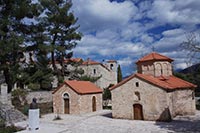
The Aghia Lavra Holy Monastery
 |
The first testimony on the monastery indicates its having been burnt to the ground by the Ottomans in 1585. It was, however, rebuilt around 1600, while the task of repainting its frescoes was completed around 1645. The historic Aghia Lavra Monastery was moved to its present location possibly around 1689, the time the katholikon’s rescued frescoes date to.
The Monastery underwent further trials and tribulations in 1715 (2nd Turkish Occupation) and particularly during the Orlov Revolt. In 1826 it was burned down by Ibrahim’s armies. It was rebuilt in 1828, with its new katholikon constructed in the domed basilica style. During the 24.7.1844 earthquake, the monastery was razed to the ground only to be rebuilt in 1850.
On December 14, 1943, the Nazis burned down the Monastery and executed its monks. In late 1950, it finally assumed its present form. That which has stamped the monastery as the sacred kindling that triggered the national uprising against the Turkish conqueror, is the fact that it was the lair of the war events surrounding the 1821 War of Independence.
As such, it claims its rightful place in the forefront of the Greek Cause for independence: The Aghia Lavra Holy Monastery was the place where Archbishop Palaion Patron Germanos, within the monastery’s domed church, declared the start of the 1821 Greek Revolution. . It is only fair that in the Greeks’ collective memory, the Monastery should be the bastion of the Greek Uprising and War for Independence.
Within the monastery, visitors may see proudly displayed: the 1821 Greek Revolution Banner;the arms of the freedom fighters; the vestments of Archbishop Palaion Patron Germanos (the figurehead of the Revolutionary Struggle); documents; manuscripts; printed material; icons; priceless gospel books (including the one donated by Katherine the Great of Russia); and sacred vessels and vestments (crosses, reliquaries, chalices; etc) all art and national treasures and all present despite the ravages of destructive fires and calamities the monastery has been subjected to.